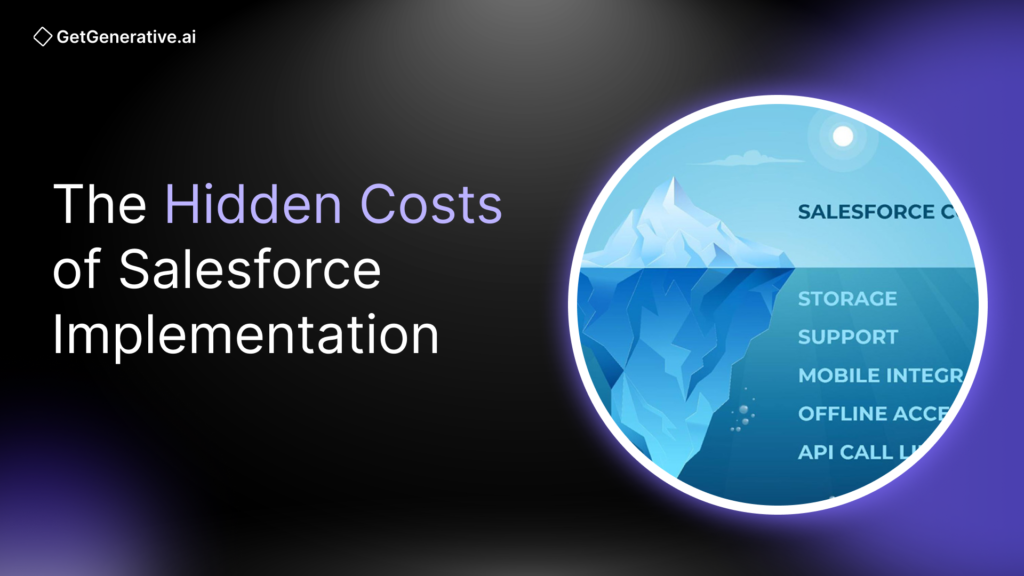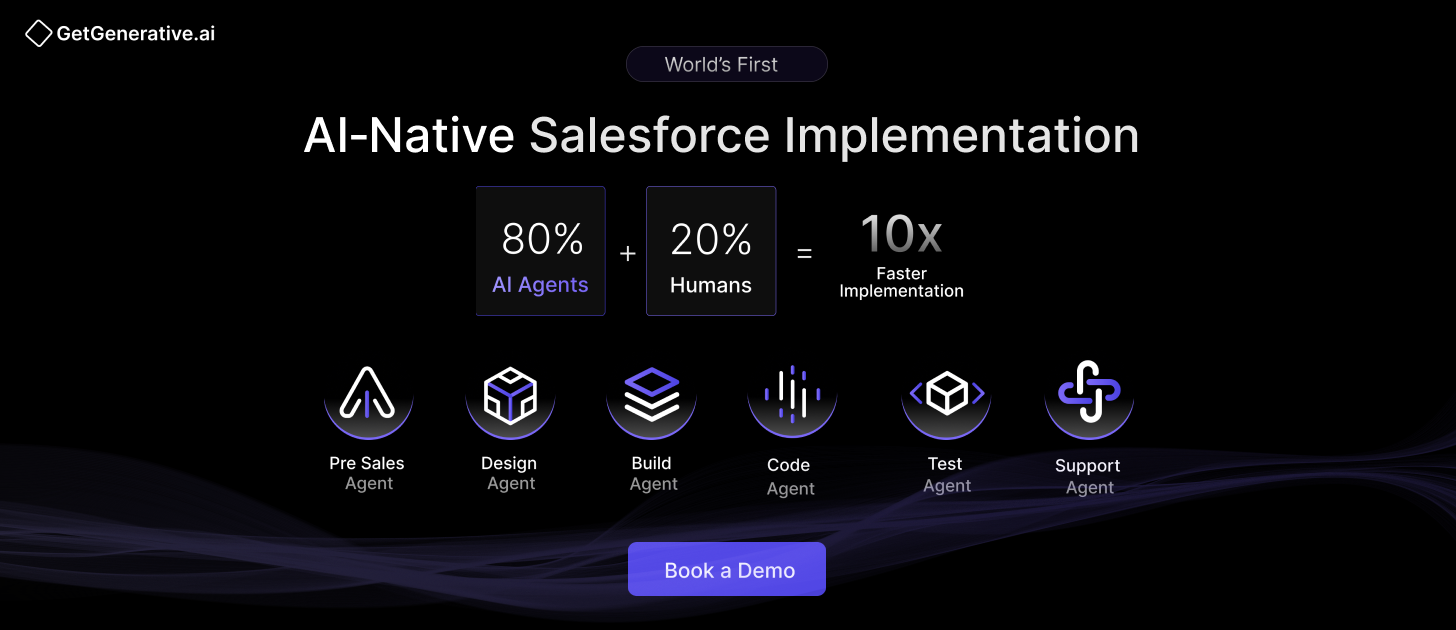The Hidden Costs of Salesforce Implementation
Industry research shows that nearly 70% of software projects face budget overruns, and Salesforce implementations are particularly vulnerable because of the platform’s depth, customization needs, and ecosystem complexity. While organizations may allocate $25,000 to $500,000+ upfront, the total cost of ownership often doubles within the first two years.
Recognizing and preparing for these hidden costs is not simply about tighter budget management. It’s about making strategic choices that determine whether Salesforce becomes a competitive advantage or an unexpected liability.
Why Visible Costs Tell Only Half the Story
Beyond the License Fee Foundation
Executives often start their Salesforce evaluation by reviewing subscription tiers, which range from $25 per user monthly for basic plans to $500+ per user for unlimited functionality. But licensing accounts for only 30–40% of the total implementation budget.
The real costs lie beneath the surface, much like an iceberg:
- Implementation services: 35–45% of budgets
- Data migration: 15–20%
- Training and change management: 10–15%
- Ongoing support: 5–10% annually
These figures shift based on the size, industry, and complexity of an organization. What remains consistent is that the hidden 60–70% of costs often go unaccounted for in early planning.
The Compounding Cost Phenomenon
Unlike one-off expenses, Salesforce costs reinforce each other. For example:
- A complex customization increases the need for API calls, which inflates integration expenses.
- Adding third-party applications consumes extra storage, leading to overage fees.
- Every system change requires additional user training, raising change management costs.
Analysts note that organizations beginning with $500,000 annual Salesforce budgets frequently exceed $1 million annually within three years. This pattern is not merely scope creep; it reflects the interconnected nature of the Salesforce ecosystem, where one decision creates ripple effects across the cost structure.
Customization Costs: The Double-Edged Sword of Flexibility
The Customization Trap
Salesforce’s adaptability is its biggest strength—and its most dangerous cost driver. Organizations spend $10,000 to $85,000 on customizations on average, but these expenses extend beyond development. They include:
- Ongoing maintenance and optimization
- Adjustments during Salesforce’s three annual updates
- Technical debt created by over-customization
Research suggests that for every dollar invested in custom development, $0.41 of technical debt is generated. Over time, this creates significant obligations that organizations rarely anticipate.
Performance can also degrade with complex workflows, excess custom fields, or non-standard configurations, forcing costly remediation projects. Worse, every new Salesforce release can break custom elements, leading to recurring testing and reconfiguration expenses.
Strategic Customization Management
High-performing organizations balance flexibility with sustainability by:
- Defining governance frameworks for when to customize vs. when to use standard features
- Conducting code reviews and documentation for future teams
- Reserving custom work only for mission-critical business differentiators
Also Read – Typical Salesforce Implementation Costs in 2025: Complete Pricing Guide
Integration Complexities: Connecting the Disconnected
Legacy System Integration Challenges
Data migration and integration account for 15–20% of budgets, but this often balloons when legacy systems are involved. Common cost drivers include:
- API limitations, which force companies to purchase costly middleware solutions
- Custom development needs, when older systems lack modern integration capabilities
- Data errors, discovered late in testing, requiring expensive remediation
Poor data quality—duplicate records, inconsistent formatting, incomplete information—can trigger multiple migration attempts, adding weeks to timelines and thousands of dollars to budgets.
Integration Cost Management Strategies
To control these costs, leading organizations:
- Conduct data audits before implementation to identify quality issues early
- Use enterprise integration platforms instead of brittle point-to-point connections
- Prioritize standard connectors when possible to reduce dependency on custom code
While upfront audits and enterprise platforms may seem expensive, they deliver higher ROI by preventing costly surprises and future rework.
Data Storage and API Overages: The Recurring Cost Escalators
Storage Cost Escalation
Salesforce’s storage model is one of the most predictable hidden costs. Standard editions provide:
- 1GB of data storage + 10GB of file storage per org
- Additional storage at $125/month per 500MB (data) or $5/month per GB (files)
With Salesforce environments growing rapidly, data usage typically doubles annually. Over three years, storage costs alone can surpass initial licensing fees.
By comparison, external cloud providers charge ~$0.023/GB monthly, versus Salesforce’s $5/GB—a staggering 217x price difference. Optimizing data management strategies is therefore critical to long-term cost control.
API Limit Management
API calls are another hidden drain. Most Salesforce editions cap daily calls at 15,000, and every integration interaction counts. Exceeding this limit requires:
- Purchasing additional API capacity
- Or upgrading to higher-tier editions
Both options drive recurring costs that scale with system complexity and business growth.
Also Read – Salesforce Implementation Consulting Services by GetGenerative.ai
Third-Party Application Ecosystem Costs
AppExchange Hidden Expenses
The Salesforce AppExchange marketplace is vast, offering 9,000+ apps, and 91% of customers use at least one. But while these solutions often seem affordable, true costs add up:
- $25–100+ per user monthly for premium apps
- $50+ per user for Einstein AI add-ons
- $75+ per user for advanced analytics
Additionally:
- Security reviews cost $999 per submission, often passed on to customers
- Certain apps require specific Salesforce editions or additional licenses
Strategic Application Selection
Enterprises must calculate total cost of ownership (TCO) when selecting apps, factoring in licensing, implementation, training, and maintenance. Adopting fewer, more comprehensive apps generally provides better ROI than patching together numerous point solutions.
Training and Change Management
Adoption Cost Reality
Technology alone doesn’t guarantee success—people do. Training and change management consume 10–15% of Salesforce implementation budgets, but their impact on ROI is far greater. Without effective training, adoption lags, productivity declines, and organizations may need costly remedial programs.
Training investments vary widely:
- $500–$5,000 per user, depending on role complexity
- Multiple user groups (sales, service, admins, executives) require tailored training
- Ongoing refresher sessions are often necessary as features evolve
When neglected, change management failures result in hidden costs like extended productivity loss, poor morale, and resistance that undermines business goals.
Maximizing Training ROI
To minimize these risks, leading enterprises:
- Roll out phased training programs, delivering content “just in time” to avoid overwhelming users
- Create internal champion networks who drive adoption and provide peer-level support
- Blend e-learning, workshops, and role-specific guides for diverse learning preferences
Organizations that invest upfront in structured adoption strategies typically achieve faster time-to-value and avoid the compounding costs of poor adoption.
Ongoing Support and Maintenance: The Long-Term Commitment
Maintenance Cost Planning
A Salesforce project doesn’t end at go-live—it enters a costly, ongoing support phase. Post-implementation support usually costs 15–20% of annual licensing fees. This includes:
- User support and troubleshooting
- System administration
- Enhancements to accommodate quarterly Salesforce updates
Staffing choices also shape costs:
- Internal admins earn $80,000–$170,000 annually
- Managed services range from $5,000–$45,000 per project
Since Salesforce delivers three major updates per year, organizations with heavy customizations face recurring testing and configuration expenses that often rival original implementation costs.
Support Strategy Optimization
Small and mid-sized firms often find managed service providers more cost-effective, offering on-demand expertise without a full-time salary burden. Larger enterprises, by contrast, may benefit from dedicated in-house teams, supplemented by external experts for specialized needs.
Also Read – Speed Up Salesforce Implementation Without Expanding Your Team
Consultant and Implementation Partner Costs
Professional Services Investment
Consulting expertise is one of the largest cost drivers:
- Rates vary from $70–$300+ per hour
- Projects often require 100–1,000+ hours of consulting
- Models include fixed-fee, time-and-materials, or retainer agreements
Offshore consultants can reduce expenses by 60–70%, but risks include communication gaps, time zone delays, and quality challenges.
Consultant Selection Strategy
Cost shouldn’t be the only selection factor. Executives should prioritize:
- Industry expertise and Salesforce certifications
- Proven project portfolios
- Reference checks and pilot engagements
Hybrid approaches—combining strategic direction from senior consultants with execution by cost-effective teams—often deliver the best balance of quality and budget control.
Budget Overrun Prevention Strategies
Proactive Cost Management
Avoiding hidden costs begins with planning. Executives should ensure:
- Comprehensive requirements gathering to avoid rework
- MVP approaches to deliver quick wins before scaling
- Governance frameworks with strict scope control
Financial Controls and Monitoring
Disciplined financial management is equally critical:
- Monthly budget reviews with variance reporting
- 20–30% contingency buffers for unforeseen costs
- Change control processes to prevent unchecked scope creep
This approach transforms cost management from reactive firefighting into proactive prevention.
Conclusion
Salesforce implementation is a strategic investment that requires continuous management. Hidden costs—from customization and integrations to training, storage, and ongoing support—are inevitable. The difference between failure and success lies in whether executives plan for them proactively.
At GetGenerative.ai, we’ve reimagined Salesforce implementation—built from the ground up with AI at the core. This isn’t legacy delivery with AI added on. It’s a faster, smarter, AI-native approach powered by our proprietary platform.
👉 Explore our Salesforce AI consulting services




